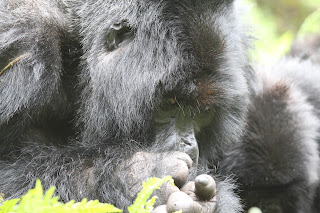The 2nd morning, was always going to be a bit draining.
 |
| Seemed odd to have a cafe on-site |
I
was off to the Genocide Memorial & Museum. Having been to
Auschwitz earlier this year, I must confess to having been
disappointed with that experience; I wasn’t quite sure what to expect in
Kigali. The former had felt like a Disney-conveyor-belt type of
encounter: where we were hurried along past gruesome exhibits of
prosthetic limbs and human hair, without a chance to take it all in;
without a chance to let the gravity and thus emotion of it all sink in.
The Rwandan display of man’s most heinous depths was a complete contrast.
 |
| A "few" names of the thousands who perished |
For a start, there were far fewer people, so managing crowds wasn’t really an issue.
I
picked up my audio guide (which thanks to being a resident in East
Africa, was much discounted at US$5) and began my leisurely stroll around the
memorial gardens. There were roses planted in remembrance and fountains
representing life – ironically the fountains seemed to be under repair,
so the absent flowing water added to the eeriness of the place. In the
middle of this were several huge slabs of concrete, where several
thousand people had been buried en masse. This was such an horrific
event, carried out over such a compacted range of time, all the names
are not even known for the remembrance wall.
 |
| The mass graves |
|
It’s
staggering to think that one group (the Hutus) could be so prepared, so
psyched up and filled with such blind hatred to manage to slaughter
over 800 000 – yes EIGHT HUNDRED THOUSAND – of their fellow countrymen
(Tutsis) in a few bloody nauseating weeks.
But they did and humanity
slumped to its knees once again as it did with Nazism, Pol Pot and the
Khmer Rouge and even more recently the Balkan massacres in and around
Bosnia.
I
took it all in my stride, pausing, reading, disbelieving but
accepting. The audio guide whirred with one fact and
historical reference after another. We did background, build up,
colonial posturing, butchering, aftermath, UN ineptitude, re-building.
But I then had to brave the worst room of all – the children’s room.
Here,
contrasted with bright orange painted walls, was a gallery about the lives of about 20
children, whose super-enlarged photos were posted around the place.
Each had a brief list of the same things: name, age, favourite game,
hobby and how they had been killed: shot, machete’d, beaten to death or
simply thrown against a wall. The terrible, wasteful result was the
same – so much lost and for what?! The emotion was palpable and I was
glad this was the last room. I’d had enough.
Walking
out into the bright sunlight, and with a panoramic view of the “new”
Kigali and by extension the “new” Rwanda, you almost forget what you’ve
just witnessed inside. The juxtaposition is unnerving.
However, we had to move on.
 |
| The volcanoes come into view |
We
started our drive to Musanze, which is where the Virunga national park
starts. The winding road weaved its way upwards, climbing all the time
on newly Chinese-funded Tarmac. And greenery, lush, fertile greenery.
The volcanoes had done their job in making this corner of Africa
incredibly fecund and almost every available inch of the hillsides were
peppered with little farms – terraces neatly carved out of the steep
slopes, some of which were almost vertical.
 After
about 2 hours, they finally came into view: 3 majestic (extinct)
volcanoes, looming in the distance – and these were only part of the
Virungas – there are 5 in total – one even with a lake on the top.
After
about 2 hours, they finally came into view: 3 majestic (extinct)
volcanoes, looming in the distance – and these were only part of the
Virungas – there are 5 in total – one even with a lake on the top.
I
got to the lodge shortly after and chilaxed as they say in my room,
complete with roaring fire and watched the film "Gorillas in the Mist" on my iPad.
I then snuggled up with my hot-water bottle under the covers and tried
to get some sleep before my 0530 wake-up call and the trek to see the
animals I’d longed to see in real-life for over 15 years.
Unsurprisingly, I didn’t sleep a wink...!



















